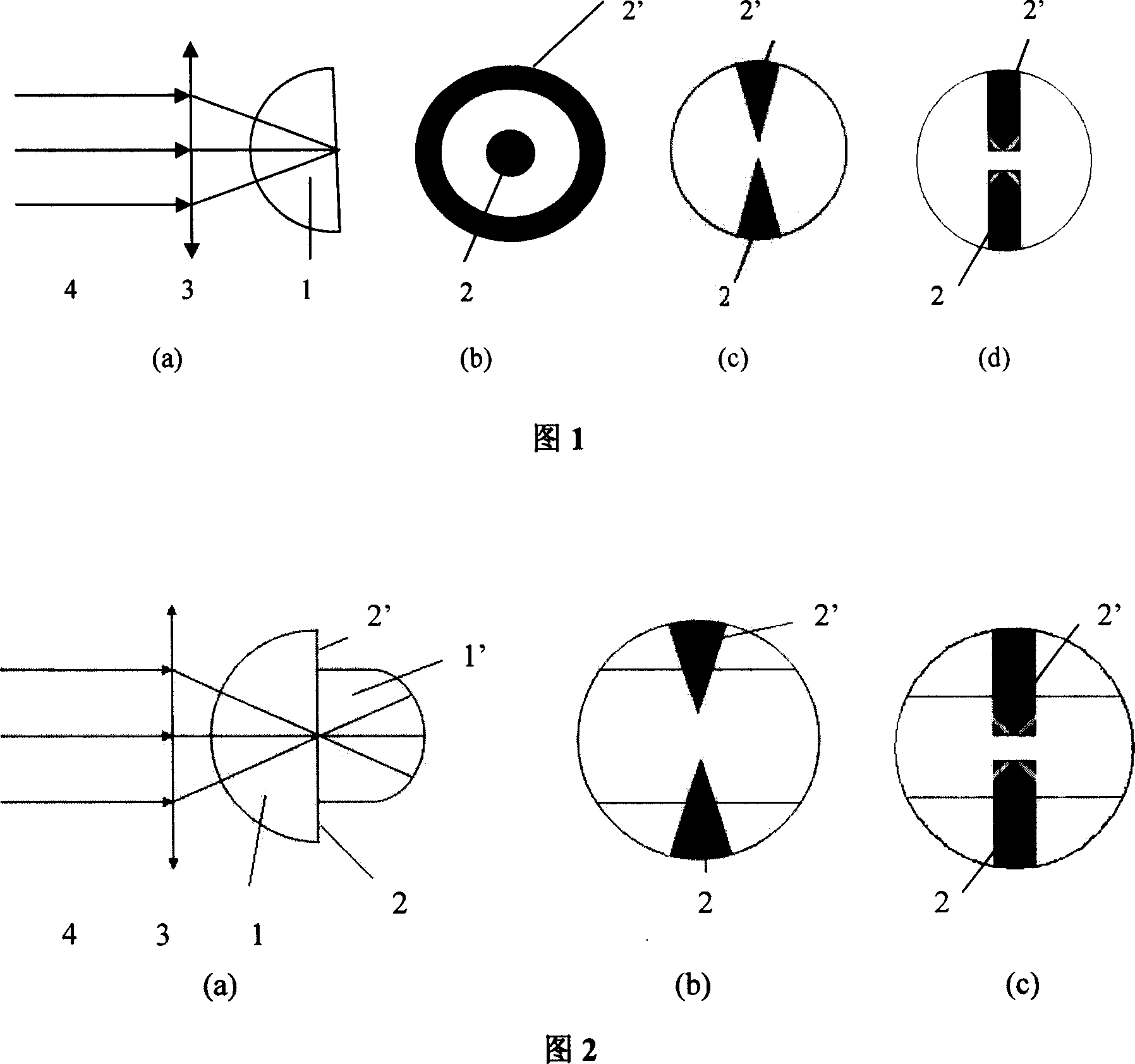Hemi-spherical shape and spherical two-photon response semiconductor photoelectric detector
A photodetector and semiconductor technology, applied in the field of information science and technology, can solve problems such as complex manufacturing process
- Summary
- Abstract
- Description
- Claims
- Application Information
AI Technical Summary
Problems solved by technology
Method used
Image
Examples
Embodiment 1
[0031] 1. The wavelength of the laser to be measured is 1.3 microns, the photon energy is 0.95 electron volts, and the photon energy of the frequency-doubled light is 0.95×2=1.8 electron volts. Because GaAs has a forbidden band width of 1.42 electron volts and a refractive index of about 3.4, a semi-insulating GaAs material is selected to make a hemispherical two-photon response photodetector.
[0032] 2. Select a microscope objective lens with a numerical aperture (NA) of 0.3 and a working distance of 6 mm for focusing. The radius of the GaAs hemisphere was determined to be 3 mm.
[0033] 3. Using the usual optical lens processing technology, the gallium arsenide material is processed into a hemisphere with a radius of 3 mm. And the usual optical polishing of spherical and flat surfaces. The error is ±0.01 mm, and the finish is grade 2.
[0034] 4. Fabricate metal electrodes in the plane of the hemisphere using conventional semiconductor technology. The aluminum electrode...
Embodiment 2
[0038] 1. The wavelength of the laser to be measured is 1.06 microns, the photon energy is 1.17 eV, and the photon energy of the frequency-doubled light is 1.17×2=2.34 eV. Because the forbidden band width of zinc telluride is 2.26 electron volts, and the refractive index is about 2.7, the unintentionally doped zinc telluride material is selected to make a hemispherical two-photon response photodetector.
[0039] 2. Select a microscope objective lens with a numerical aperture (NA) of 0.3 and a working distance of 6 mm for focusing. The radius of the ZnTe hemisphere was determined to be 3 mm.
[0040] 3. Using optical lens processing technology, the zinc telluride material is processed into a hemisphere with a radius of 3 mm. And for spherical and flat polishing. The error is ±0.01 mm, and the finish is grade 2.
[0041] 4. Fabricate metal electrodes in the plane of the hemisphere using conventional semiconductor technology. Gold electrodes are deposited in the plane of the ...
Embodiment 3
[0045] 1. The wavelength of the laser to be measured is 1.55 microns, the photon energy is 0.80 electron volts, and the photon energy of the frequency-doubled light is 0.80×2=1.60 electron volts. Because the forbidden band width of silicon is 1.12 electron volts and the refractive index is about 3.4, the near-intrinsic silicon material is selected to make the two-photon response photodetector.
[0046] 2. Select a microscope objective lens with a numerical aperture (NA) of 0.3 and a working distance of 6 mm for focusing. The radius of the silicon hemisphere was determined to be 3 mm.
[0047] 3. Using optical lens processing technology, the silicon material is processed into a hemisphere with a radius of 3 mm. And for spherical and flat polishing. The error is ±0.01 mm, and the finish is grade 2.
[0048] 4. Fabricate metal electrodes in the plane of the hemisphere using conventional semiconductor technology. Aluminum electrodes were evaporated in the plane of the hemisphe...
PUM
 Login to View More
Login to View More Abstract
Description
Claims
Application Information
 Login to View More
Login to View More - R&D
- Intellectual Property
- Life Sciences
- Materials
- Tech Scout
- Unparalleled Data Quality
- Higher Quality Content
- 60% Fewer Hallucinations
Browse by: Latest US Patents, China's latest patents, Technical Efficacy Thesaurus, Application Domain, Technology Topic, Popular Technical Reports.
© 2025 PatSnap. All rights reserved.Legal|Privacy policy|Modern Slavery Act Transparency Statement|Sitemap|About US| Contact US: help@patsnap.com

